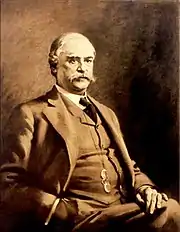Partnership to End Addiction
Partnership to End Addiction is a New York City-based non-profit organization. The organization was formed following the merger of two addiction-focused nonprofit organizations: The Partnership for Drug-Free Kids (2014–2019) and the National Center on Addiction and Substance Abuse (1992–2019). The Partnership for Drug-Free Kids was previously known as the Partnership for Drug-Free America (1985–2010).[1]
| Formation | 1985 |
|---|---|
| Founder | Phillip Joanou |
| Type | National Non-Profit |
| 13-3413627 | |
| Focus | Support for families struggling with a loved with suffering from a substance use disorder |
| Headquarters | 711 Third Avenue 5th Floor, Suite 500 |
| Location | |
Area served | United States |
| Method | Family Support, Substance Use and Addiction Prevention, Treatment, and Recovery |
Chief Executive Officer | Creighton Drury |
Employees | 100 |
| Website | https://drugfree.org/ |
Formerly called |
|
The organization is most widely known for its iconic TV ad This Is Your Brain on Drugs. Currently, it aims to assist parents in prevention efforts. The organization uses input from scientists, specialists in communication, and researchers to inform and offer resources for parents and teenagers on its website.[2] It focuses on efforts to "unsell" illegal drugs such as cocaine,[3] heroin,[3] prescription drugs, marijuana, MDMA, and others, as well as discouraging the use of alcohol and nitrous oxide. While the organization has focused drug prevention advertising on broadcast media such as television, it has recently shifted media support to channels such as video-on-demand and digital technology.[4] The organization's marketing experience was written up as a 58-page[5] marketing "case study" for study by students at the Harvard Business School.[6][7]

History

Strategic vision
In the mid-1980s, a small group of advertising professionals with wide–ranging experience on diverse campaigns, and working in conjunction with a nonprofit trade association called the American Association of Advertising Agencies, proposed a marketing campaign not to sell one more product or service, but rather to un-sell teenaged drug use. The group was formed officially in 1985.[3][8] Among the initial group was Los Angeles "ad guru" Phillip Joanou,[3] Thomas Hedrick,[3] Doria Steedman,[3] and Ginna Marston from the Ted Bates advertising agency. The group saw the merits of using a focused approach similar to that for a commercial product or service. In earlier decades, public service ads or PSAs had been shown by networks whenever it had been convenient for their schedules, regardless of the intended audience of the ad. Many PSAs aired late at night when most people had gone to sleep. In other situations, networks used PSAs as filler when slots opened up in their commercial lineup regardless of any consideration for reaching specific audiences. Marston urged, instead, a targeted focused anti-drug campaign similar to one for selling a specific brand of cereal or an automobile, but instead, the campaign would unsell drugs[9] or rather sell the benefits of not using drugs. Like a commercial campaign, the effort would conduct marketing research by studying teenagers and parents in depth using focus groups to understand their motivations, as well as conduct quantitative research using nationwide random-sample surveys as part of a recurring longitudinal investigation.
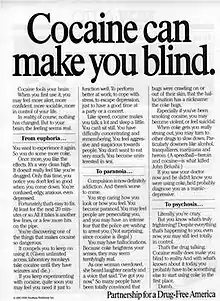
Hedrick agreed that the group knew "next to nothing about illegal drugs and the youthful target audience for their ads," according to a report in the Los Angeles Times.[3] These realizations led to the creation of a "full-time and highly aggressive research staff" according to one report. The team reached out to knowledgeable activists such as Carole Fields-Arnold, who Marston later described as "one of those rare people who is street smart, and can be tough when needed, but also gets everyone to look up and see the light, dream a bigger dream than they thought they could and lock arms to reach for it together."[10] The organization was loosely modeled along the lines of a standard advertising agency, with a creative director post[11] and "account executives" to spearhead specific efforts. While the campaign approach was a radical departure from standard PSA approaches, the group was following a tried–and– true advertising strategy: research, choosing a marketing objective, writing advertisements to meet that objective, plus focused efforts to persuade that audience in chosen media at specific times. The intent was to change behavior by changing attitudes.[9] Further, the agency did continual reassessments: were attitudes changing? was drug use becoming less prominent? This feedback helped the group decide if goals were being met, and allowed them to change tactics accordingly. An account of the overall idea:
On Madison Avenue, it is still revered as one of the hottest marketing ideas of all time. Take the decision to buy and use heroin (or pot, or coke or any illegal drug) and treat it like any other purchasing choice. Liken potential addicts to a group of consumers whose buying habits can be manipulated by celebrity endorsements, catchy slogans, and powerful images. Then use those tricks not to sell the product, but to un-sell it. If the approach works, drugs will finally lose their cool.
_production_assistant_(center)_Ginna_Marston_(right).jpg.webp)
Photo by Bobby Sheehan
The agency found itself able to solicit help from many sources, for free. Copywriters often competed for assignments[3] on a pro bono basis.[3] The agency finagled free media exposure from print media and broadcast networks[3] including spots during prime time.[3] Later, when advertising was directed at inner-city youth, media was selected to target 37 large cities.[12] The organization has turned to media planning and placement experts who work, as well, on a pro bono basis.[4] One report suggested that there was a wealth of creative talent vying for a chance for assignments.[3] The group was prepared to feature rather risqué push–the–envelope ads; for example, one advertisement showed a girl with the "barrel of a revolver pushed up one nostril and a father singing a lullaby to his little daughter from his coffin."[3] Doria Steedman described the ads as neither pretty nor polite nor nice but designed deliberately to "disturb and upset."[3] A bandwagon effect happened soon thereafter: big advertising agencies including Saatchi & Saatchi, J. Walter Thompson, BBDO Worldwide joined the consortium. Key executives from The New York Times Company, Procter & Gamble, USA Network and others such as Daniel Burke of Capital Cities[13][14] sat on the Partnership's board of directors.[3]
Funding
The Partnership found office space on the 16th floor of the Chrysler Building in New York City.[3] By 1993, it had 30 employees, according to one estimate.[5] An early grant of $300,000 from the American Association of Advertising Agencies helped considerably to pay for rent, salaries, and other expenses,[3] and subsequent funds were provided by generous grants from the Robert Wood Johnson Foundation, a Princeton-based philanthropic organization focusing exclusively on health care and particularly substance use disorders. The foundation's founder, Robert Wood Johnson II, had built the family firm of Johnson & Johnson into an international health care products manufacturer, and he left the foundation a generous bequest of stock upon his death in 1968.[15] In addition to these revenue sources, the organization also holds fundraisers, including an annual awards dinner; in 2007, one awards dinner at the Waldorf-Astoria Hotel raised $2.2 million.[16]
This Is Your Brain on Drugs
Analysis of research suggested that consumers decided about possibly doing drugs based on two basic considerations: the risk involved, and the perception of social disapproval.[3] And campaigns were targeted towards both mindsets: that using drugs was risky and that it was uncool among peer groups.

The organization first entered the wider public consciousness in 1987,[9] with its This Is Your Brain on Drugs broadcast and print public service advertisements (PSAs).[17] The advertisement used the analogy that if a person's brain is an egg, then using illegal drugs would be like frying it.[17] This advertisement was shown repeatedly on broadcast media to the extent that it became a hallmark for the organization. Time magazine described the advertisement as "iconic".[17] It has been recognized by marketing professionals as "one of the most influential" ad campaigns in the history of marketing, according to numerous sources,[9][17] and has been applauded as one of the "most unforgettable images in modern American advertising."[3] TV Guide named it as one of the "top 100 ads of all time".[9] The ad became the organization's "calling card", according to one account.[3]
The ad had varyingly impactful effects on viewers. Student Taia Lubitz felt the "brain on drugs" commercial was not accurate, since she saw fellow students smoking marijuana whose brains were clearly not frying. She claimed that the ad "stirred her curiosity" and that the scare tactic was really more of a "dare" tactic.[9] Student Sepideh Modrek said that "The fried egg commercial really scared me when I was in high school. I remember picturing that egg in the frying pan and thinking that it wasn't worth it."[9]
The agency was able to solicit generous donations of free media time with an estimated worth of "$1 million worth of advertising every day" for more than a decade, totaling more than $2 billion in free space and time, according to one estimate.[3] Copywriters from big-city agencies in Los Angeles, Chicago, New York and elsewhere from "250 big-name ad agencies" contributed their creative expertise.[3]

Coordination with federal anti-drug efforts
The agency coordinated efforts with government officials in their efforts to stem illegal drugs. However, the relationship between the Partnership and the federal government was sometimes marked by disagreements. In 2002, the White House director of the Office of National Drug Control Policy, John P. Walters, questioned whether the Partnership's campaigns were lessening the use of illegal drugs.[18] Partnership chairman James E. Burke argued before a Senate subcommittee for better targeting of funds for media purchases.[19] Burke complained of improper interpretations of survey data as well as the federal government shifting $50 million away from vital media purchases.[19] Burke called for simplicity and focus:
The resulting campaign is far too complex, calling as it does for the lockstep shuttling in and out, at 6 to 8 week intervals, of TV, radio, print, outdoor and interactive messages in multiple languages against 36 different strategies aimed at eleven different targets.
— James E. Burke, to a Senate subcommittee, 2002[19]
The Partnership holds a special position under law within the National Youth Anti-Drug Media Campaign of the Office of National Drug Control Policy.[20][21] It cooperates with government agencies in many initiatives to try to help reduce drug use. In 2010, it worked with the Drug Enforcement Administration in 2010 on a public relations event entitled "National Prescription Drug Take-Back Day."[22] The event involved 4,000 so-called "drop spots" for people to discard extra prescription drugs as a way to lessen the temptation for their misuse.[22]
The 1990s
In 1989, Johnson & Johnson chief executive James E. Burke took over leadership of the organization.[18] Burke held a reputation for having high ethical standards.[23]
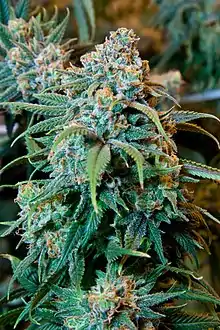
In 1992, the Partnership switched focus to targeting inner-city youth, where the drug problem had been more severe, and ran a campaign led by Ginna Marston.[24] Research suggested most children felt "nearly alone in their hostility toward drugs," so an effort was made to show them that they were not alone.[24] In one television commercial, a camera zooms in and out on two adolescents, one of whom is trying to get the other to try marijuana. The tagline then reads: "A friend who offers you drugs is not your friend."[24] It was a "strikingly different tack" from the milder Just Say No campaign championed by previous first lady Nancy Reagan.[8] Commercials written by a former Wieden & Kennedy copywriter were "infused with menace and melodrama" according to one report.[8] Some spots by a Goodby, Berlin & Silverstein copy team hinted that the earlier Just Say No had been simplistic.[12] Marston explained the utility of depicting young people "resisting drugs in real situations":[24]
The new campaign addresses kids' feelings and their sense of emotional isolation on this issue. ... The problem is not drugs, but an attitude of hopelessness ... They start to feel they don't count, they don't matter. They feel bad about themselves and give up on themselves; those are the ones who get into drugs ... It's not to kill time, as happens in the general market ... but to kill pain.
The organization picked up real-life stories about the effects of drug use and used these stories at times in its commercials. For example, a 28-year-old former drug user met for lunch with the Partnership's Doria Steedman, and at one point "pulled out her [false] teeth" to show the ravages of the drug use; this idea was used in a subsequent commercial.[3]
In 1994, an independent assessment from the Johns Hopkins School of Medicine suggested that the anti-drug campaign was having a measurable "deterrence effect" on American adolescents:
No one presumes advertising is going to stop all drug abuse in America ... Using the idea that attitudes change behavior and using the best ad minds to denormalize drug use, they have sent a very strong message over the years, and their work is a very important component in the national effort to reduce drug use."
Research efforts suggested that a key metric for the agency was getting preteens and teenagers to wait longer and longer before having their "first taste of drugs" since the longer wait period meant that it became less and less likely that a child would become a regular drug user.[3]
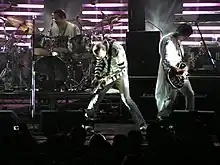
In 1996, Partnership director Ginna Marston noticed, after examining survey data, trends indicating that not just teenagers, but preteens were showing greater smoking of marijuana and that the problem could no longer be viewed as a "teenage problem only."[25] At a press conference, Marston told reporters of a new media blitz aimed at "getting parents involved in the war against drugs.[25] Survey data showed marijuana use had gone from 230,000 children in 1995 to 460,000 children in 1996, according to the report.[25] In addition, there continued to be high-profile deaths of celebrities who had overdosed, such as Jonathan Melvoin of the group The Smashing Pumpkins, which put pressure on the music industry to take a serious look at drug influence in pop music.[26]
The Partnership turned images of glamour upside down by juxtaposing the illusory world of drugs versus the reality:
Glamorous parties, a night on the town.
With beautiful people, it's always around!
Everybody's doin' it, doin' it. ...Her-o-in! For the rest of your life!
- Television jingle accompanying black-and-white footage of a grimy boy twitching and retching into a filthy toilet[3]
Since the agency had been tracking usage and attitudes, it adapted to changing circumstances. Marston and other executives adjusted their media strategy accordingly as fast-moving trends made one drug "hot" while others fell out of favor.[3] The campaign was primarily oriented towards television and print media.[27] An analysis of the Partnership's efforts by Forbes magazine around this time suggested that it had earned "a single-brand advertising clout" comparable to McDonald's while noting that the fast-food franchisor outspent the Partnership by a ratio of "2 to 1."[3]
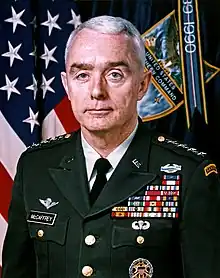
The Partnership coordinated efforts with Drug Czar Barry McCaffrey, a retired general who was the director of the Office of National Drug Control Policy, in targeting efforts against heroin. McCaffrey endorsed the Partnership's campaigns and spoke at their news conferences.[3] Later, it worked with state alliance programs. [12]
In 1998, Marston noticed how game maker Fox Interactive had marketed its game N2O as being the "ultimate rush" and how game designers had used "the music and images of the drug-infused rave scene to appeal to hip consumers", according to one report.[28] Marston criticized the blatant approach:
... just one example of the kind of stuff that we see all over now, especially on the Internet – information that glamorizes drugs and exploits the language and imagery of drug culture.
During these years, it was a continuing effort to persuade media sources to provide the best spots and airtime. Newspapers such as the New York Times and Washington Post had generously given prime full-page spots for their ads, but "few other papers have been so generous", according to one account.[3]
.jpg.webp)
The Partnership got some help from the pop culture movie industry. In 1999, filmmaker Robert Zemeckis made a documentary entitled The Pursuit of Happiness: Smoking, Drinking and Drugging in the 20th Century which made an in-depth examination of the problem of drug use, covering 100 years and interviewing professionals and historians.[29] Zemeckis included Marston in the documentary film.[30] The film suggested, among other things, that "American society has habitually criminalized the substances used primarily by minorities" such as opium for Asian immigrants and marijuana and cocaine for African-Americans while legalizing those of white adults such as beer, alcohol and tobacco.[30] In addition, the documentary suggested that the 1920–1933 alcohol prohibition was a result of entrepreneurs such as Henry Ford needing sober assembly line workers.[30] Marston commented later in the New York Times:
Considering that it wasn't intended to be an antidrug piece, but a comprehensive and sophisticated treatment of a very complex issue, I thought it was great.
— Ginna Marston, 1999[30]
The 2000s
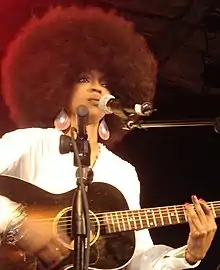
The firm continued its efforts to make drug use look uncool, in part by getting celebrities to help them break the "age-old stereotype of sex, drugs, rock-'n'- roll going together with everything cool", according to Marston commenting on CNN.[31] Celebrities such as Lauryn Hill and the Dixie Chicks came forward to say they're "drug-free".[31]
In 2002, Burke retired as chairman, and was replaced by Roy J. Bostock.[18]
Tracking research showed a decline in usage of alcohol and cigarettes, and that use of the club drug ecstasy had declined among teens.[32] The Partnership had been tracking ecstasy use since 1996, and found that 52% of students were aware of the dangers associated with its use as compared to 46% from the year before.[32] Marston said:
You still have way too many kids using a drug that could kill them.
In the mid-2000s, the Partnership gradually shifted away from de-emphasizing the perils of marijuana and focused more on targets such as prescription drugs, possibly responding to a shift of emphasis by the U.S. government, the growing cultural acceptance and push for legalization of marijuana as well as possible indications of declining marijuana usage by teens.[33] Reporter Elizabeth Sprague of CBS News noticed that the Partnership had not produced a single anti-marijuana PSA since 2005.[33] In a conflicting report in 2011, a study suggested that there were "sharp increases in the use of marijuana" as well as ecstasy after "years of declining use."[34] The "frying pan" ad was described as a "relic" in one report, although New York Sun reporter Amanda Gordon noted that the organization gives gold-plated frying pan awards (mounted under glass) at fundraisers.[35] By 2007, the agency had produced over 3,000 spots from 1985 to 2007.[35]
In 2010, the organization changed its name from Partnership for a Drug-Free America to Partnership at Drugfree.org, possibly as a result of increased emphasis on websites and Internet appeals.[36]
Current approaches

In 2011, a study found that marijuana use was increasing, as well as the use of ecstasy and found that 45% of teenagers did not think drinking alcohol was "a big deal."[37][38] The Partnership was focusing more on teenagers' misuse of prescription drugs; one study they did suggested that on any given day, 2,500 American teens get high for the first time by using prescription medication.[39] The group was part of a campaign known as National Prescription Drug Take Back Day which encouraged residents to dispose of their old prescription drugs to nearby city halls or police departments.[39] Partnership executive Sean Clarkin suggests that parents sit down with their teens and ask "what's going on" as a possible beginning of a conversation.[40] There was one report that the Partnership will be reducing its commitment to broadcast media in favor of an approach of reaching out to parents,[41] particularly via the Internet, which increased from 10% of its budget to 31% for 2010.[4] It has focused on web efforts such as the site "Time to Talk" (timetotalk.org), and is exploring the possibility of advertising on cell phones and possibly in video games.[4] The drugfree.org website, according to one source, attracts a million visitors each month.[4] The agency is making a $55 million three-year commitment with cable operator Comcast including its "Time to Talk" campaign.[4] There was a report that it will sponsor a toll-free hotline.[35]
Research findings and tracking
The Partnership has consistently done a tracking study as part of an ongoing longitudinal study to assess attitudes towards drugs and alcohol. The survey research helped it keep on top of trends, although since in many cases research organizations were providing studies without cost, the Partnership had less ability to impose a strict study design on some of the efforts. As a result, some surveys, using different questions and designs, conflicted with other survey data, although on key tracking measures, the Partnership was able to follow shifts in teenaged awareness and attitudes towards drugs.[42]
| Year | Key findings | Survey sponsor | Survey size | Notes |
|---|---|---|---|---|
| 1996 | Marijuana use among US preteens doubled | [25] | ||
| 2002 | More than 2/3 of teen girls say drugs helps kids cope with problems at home | MetLife Foundation | 3,287 teenagers | [42] |
| 2002 | Use of ecstasy, cigarettes, alcohol declining | 44,000 | [32] | |
| 2007 | Drug use among teenagers is declining | SAMHSA, U. Michigan | [43] | |
| 2007 | U.S. schools "drug-infested"; teen drug use declining; Percent saying some students "high or drunk" increased from 2002 to 2007 | (CASA) at Columbia Univ. | 1,063 | [43] |
| 2009 | 1 in 5 teens abused prescription drugs; 1 in 3 smoked marijuana | PDFA | [44] | |
| 2010 | Boys more likely to drink to relax socially; 70% teen girls agree that "drugs help kids deal with problems at home"; 50% teen girls say drugs help them "forget problems" | PDFA & MetLife Foundation | [45] | |
| 2011 | 2,500 U.S. teens use prescription drugs each day to get high for first time | PDFA | [39] | |
| 2011 | Sharp increases in marijuana, ecstasy use; Teen attitudes towards underage drinking "more relaxed"; Most teen drinkers had first drink by age 15; 25% had first drink by age 12 | Partnership at Drugfree.org | [34] | |
| 2011 | Ecstasy use by teens up 67% during 2008–2011; One in ten teens use ecstasy; marijuana use up 22% | PDFA | [38] | |
| 2011 | 45% of teens don't see drinking alcohol as a "big deal" upward trends in marijuana and ecstasy among gr. 9–12 | Partnership at Drugfree.org | ||
| 2012 | Only about 1 in 10 people with addiction involving alcohol or drugs other than nicotine receive any form of treatment. | (CASA) at Columbia Univ. | 2,805 | [46] |
| 2012 | 86% of American high school students said that some classmates drink, use drugs and smoke during the school day. | (CASA) at Columbia Univ. | 1,003 teens | [47] |
| 2012 | Teens that had a less than a very good relationship with their father were: Almost 4 times likelier to have used marijuana, Twice as likely to have used alcohol, and 2.5 times as likely to have used tobacco | (CASA) at Columbia Univ. | 1,003 teens | [48] |
| 2013 | Roughly half of the parents in the survey report having used marijuana before. The number is somewhat higher (62 percent) for parents living in Colorado. | Partnership at Drugfree.org | 1,603 | [49] |
| 2013 | One in four teens has misused an Rx drug at least once in their lifetime – a 33 percent increase over the past five years. | Partnership at Drugfree.org | [50] | |
| 2013 | Individuals who engaged in pathological and underage drinking made up 25.9% of the American population, but consumed 47.3% of all alcohol consumed by underage drinkers. | Partnership at Drugfree.org | [51] |
Criticism and controversy
PDFA was the subject of criticism when it was revealed by Cynthia Cotts of The Village Voice that their federal tax returns showed that they had received several million dollars worth of funding from major pharmaceutical, tobacco and alcohol corporations including American Brands (Jim Beam whiskey), Philip Morris (Marlboro and Virginia Slims cigarettes, Miller beer), Anheuser Busch (Budweiser, Michelob, Busch beer), R.J. Reynolds (Camel, Salem, Winston cigarettes), as well as pharmaceutical firms Bristol Meyers-Squibb, Merck & Company and Procter & Gamble. In 1997, it discontinued any direct fiscal association with tobacco and alcohol suppliers, although it still receives donations from pharmaceutical companies.[52] There has been criticism that some of its PSAs have had "little proven effect on drug use."[30]
Regardless of this separation from some funding sources, PDFA has continued to receive criticism for intentionally misleading the public in relation to substance abuse. A 2013 article on Center on Juvenile and Criminal Justice describes PDFA has, "...always felt free to lie — blatantly, openly, stupidly — about drugs. In fact, lying to obscure the realities of drug abuse in order to protect powerful interests and constituencies is the reason the Partnership exists.".[53] The article continues, "The Partnership is the latest in America's long history of phony lobbies — the Office of National Drug Control Policy (ONDCP) is the White House branch — that revel in misinformation and misdirected policies that perpetuate the social crises they claim to be attacking because they tacitly profit from making them worse."
Sources
- "Brief History". The Partnership for Drug-Free Kids. 2011-12-26. Retrieved 2011-12-26.
- "Hannah Michelle Weeks on preventing teen substance abuse". Lock the Cabinet. Archived from the original on 2016-03-03. Retrieved 2013-03-11.
- Pamela Warrick (August 30, 1996). "Can You Just Say No?". Los Angeles Times. Retrieved 2011-12-24.
- Stuart Elliott (September 27, 2007). "Advertising; Public Service Groups Follow the Audience". The New York Times. Retrieved 2011-12-24.
- "(cases)". tzhealth.com. September 13, 1993. Archived from the original on 2012-04-26. Retrieved 2011-12-24.
9-594-028 Title: Partnership for a Drug-Free America (A)
- V. Kasturi Rangan (1993). "Faculty & Research: HBS Course Materials". Harvard Business School. Retrieved 2011-12-24.
Rangan, V. Kasturi, Diana Chapman Walsh, Barbara Moeykens, and Rima E. Rudd. "Partnership for a Drug-Free America (A)." Harvard Business School Case 594-028. ... Rangan, V. Kasturi, Diana Chapman Walsh, Barbara Moeykens, and Rima E. Rudd. "Partnership for a Drug-Free America (B)." Harvard Business School Supplement 594-029.
- Matthew W. Finkin (1996). "*221 Employee Privacy, American Values, and the Law". Chicago-Kent Law Review. Retrieved 2011-12-24.
(cited this case study:) See Partnership For a Drug-Free America: Overview (Partnership for a Drug Free Am., New York, N.Y.), May 1, 1996, at 1. It claims that a drop in drug usage is attributable to its efforts. See Diana Chapman Walsh et al., The Partnership for a Drug-Free America (A) 26 tbl. 5D (Harvard Bus. Sch. No. N9- 594-028, 1993).
- Stuart Elliott (October 1, 1993). "The Media Business: Advertising — The Partnership for a Drug-Free America accentuates the positive in a new campaign". The New York Times. Retrieved 2011-12-24.
- Famous fried eggs: Erika Alexander (December 6, 2000). "Students debate effectiveness, accuracy of well-known anti-drug commercial". CNN. Retrieved 2011-12-24.
- Myrna Oliver (July 16, 2004). "Carole Fields-Arnold, 59; Talent Agent Co-Founded Drug, Alcohol Program". Los Angeles Times. Retrieved 2011-12-24.
- "Rebecca Shaw, Michael Kelly". The New York Times. February 26, 2010. Retrieved 2011-12-24.
Rebecca Blackwood Shaw ... The bride, 38, plans to take her husband's name. She is the director of creative development for the Partnership for a Drug-Free America, a nonprofit organization in New York, where she oversees the production of public service announcements.
- Stuart Elliott (October 1, 1993). "The Media Business: Advertising — The Partnership for a Drug-Free America accentuates the positive in a new campaign". The New York Times. Retrieved 2011-12-24.
- Joe Flint (October 27, 2011). "Daniel Burke dies at 82; former president of Capital Cities/ABC". Los Angeles Times. Retrieved 2011-12-24.
- William Neuman (October 26, 2011). "Daniel B. Burke, Leading Media Executive, Dies at 82". The New York Times. Retrieved 2011-12-24.
- Stephanie Strom (April 4, 2007). "$500 Million Pledged to Fight Childhood Obesity". The New York Times. Retrieved 2011-12-27.
Robert Wood Johnson, who built Johnson & Johnson into one of the world's largest health and medical care products companies, established his foundation at his death in 1968 ...
- Bill Cunningham (December 2, 2007). "Evening Hours — Beginnings". The New York Times. Retrieved 2011-12-24.
- "Top 10 Public-Service Announcements: There Goes My Appetite". Time. 2011. Archived from the original on September 8, 2009. Retrieved 2011-12-24.
Produced in 1987 by the Partnership for a Drug-Free America, this iconic PSA makes use of everyday household items — namely, an egg and a frying pan — to illustrate how narcotics affect the body. (Fresh egg = your brain; fried egg = your brain on drugs.)
- Courtney Kane (October 23, 2002). "The Media Business: Advertising — Addenda — A Succession At Anti-Drug Group". The New York Times. Retrieved 2011-12-24.
James E. Burke will soon step down after 13 years as chairman of the Partnership for a Drug-Free America in New York ...
- (Senators, James E. Burke, others) (June 19, 2002). "Senate Hearing 107–600: Effectiveness of the National Youth Anti-Drug Media Campaign". U.S. Government Printing Office. Retrieved 2011-12-24.
{{cite news}}: CS1 maint: multiple names: authors list (link) - Matthew W. Finkin (Jan 7, 2011). "U.S. Code – Title 21 > Chapter 22 > § 1708: National youth anti-drug media campaign". Cornell University Law School. Retrieved 2011-12-24.
... (C) Evaluation of effectiveness of media campaign In using amounts for the evaluation of the effectiveness of the national media campaign under paragraph (1)(E), the Director shall— ... the Attitude Tracking Study published by the Partnership for a Drug-Free America;
- Office of National Drug Control Policy Reauthorization Act of 2006, Pub. L.Tooltip Public Law (United States) 109–469 (text) (PDF), 120 Stat. 3501, enacted December 29, 2006, codified at 21 U.S.C. § 1708
- Jack Shafer (Sep 24, 2010). "Bogus Drug Coverage of the Week". Slate Magazine. Retrieved 2011-12-24.
... a public-relations event staged by the Drug Enforcement Administration called the "National Prescription Drug Take-Back Day." Allied with medical boards, police chiefs, district attorneys, boards of pharmacy, and the Partnership for a Drug-Free America, ...
- Prokesch, Steven (February 19, 1986). "Man in the News — A Leader in a Crisis: James Edward Burke". The New York Times. Retrieved 2011-12-27.
In doing so in a forthright way and with his decision to stop selling Tylenol in capsule form, Mr. Burke is receiving praise from analysts, marketing experts, and consumers themselves.
- Joseph B. Treaster (October 2, 1992). "The Media Business — Television Ads Are Directed At Urban Youths and Drugs". The New York Times. Retrieved 2011-12-24.
- Times Staff & Wire Reports (March 5, 1997). "Preteen 'Pot' Use Doubles, Study Says". Los Angeles Times. Retrieved 2011-12-24.
Marijuana use among U.S. preteens doubled in 1996, ...
- Jerry Crowe (July 14, 1996). "Heroin Deaths Fuel Music Industry's Soul-Searching". Los Angeles Times. Retrieved 2011-12-24.
- Jerry Crowe (July 14, 1996). "Heroin Deaths Fuel Music Industry's Soul-Searching". Los Angeles Times. Retrieved 2011-12-24.
- Michael Colton (June 18, 1998). "To Some Critics, N2O's Not A Gas Ads for Video: Nitrous Oxide Evoke Drug Culture GameFeaturing". Washington Post. Retrieved 2011-12-24.
- "Robert Zemeckis on Smoking, Drinking and Drugging in the 20th Century: In Pursuit of Happiness". Movies & TV Dept. The New York Times. 2000. Archived from the original on 2013-01-30. Retrieved 2011-12-24.
... A feature-length documentary on smoking, drinking and drugging in the 20th century. Through interviews with historians and professionals in the drug treatment field interspersed with film clips ...
- Andy Meisler (August 29, 1999). "Television/Radio; Getting Down to What Makes America High". The New York Times. Retrieved 2011-12-24.
- "Transcripts: Newsroom for February 3, 2000". CNN. February 3, 2000. Retrieved 2011-12-24.
- Kathleen Fackelmann (December 16, 2002). "Survey: Teen drug use on decline". USA Today. Retrieved 2011-12-24.
For the first time, use of the club drug Ecstasy dropped among teens in the United States, and use of cigarettes and alcohol continued to decline, according to a just-released survey. This year's annual Monitoring the Future survey tracked substance use among 44,000 eighth-, 10th- and 12th-grade students. The survey has been tracking teens' drug use since 1975.
- Elizabeth Sprague (November 9, 2009). "Pot No Longer Focus of Anti-Drug Campaigns". CBS News. Retrieved 2011-12-24.
- David W Freeman (April 6, 2011). "Teen drug abuse rising: Why?". CBS News. Retrieved 2011-12-24.
- Amanda Gordon (November 28, 2007). "Parents and Tennagers Rock for 'Drug-Free America'". New York Sun. Retrieved 2011-12-24.
- "Accounts and People of Note in the Ad Industry". The New York Times. December 13, 2010. Retrieved 2011-12-24.
- "Study: Teens see binge drinking as no big deal". CBS News. April 6, 2011. Retrieved 2011-12-24.
When asked if they see "great risk" in drinking that much, almost half the teens questioned — 45 percent — didn't see it as a big deal. ...
- Ben Tracy (April 6, 2011). "Teenage drug abuse skyrockets". CBS Evening News. Retrieved 2011-12-24.
- "Prescription Drug Take Back Day to be held Saturday". Los Angeles Times. October 27, 2011. Retrieved 2011-12-24.
- Sabriya Rice (July 22, 2010). "Want to keep your child drug-free? Here are five signs of possible trouble". CNN. Retrieved 2011-12-24.
- "About Us". The Partnership at DrugFree.org. 2011-12-26. Retrieved 2011-12-26.
(from the webpage) The Partnership at Drugfree.org is here for parents, ...
- Stephanie Steinberg (June 26, 2010). "Teen girls say kids more likely to drink, do drugs to cope". USA Today. Retrieved 2011-12-24.
- Sharon Jayson (August 15, 2007). "Schools 'infested' with drugs? It depends". USA Today. Retrieved 2011-12-24.
- Valerie Ulene (June 8, 2009). "Parents: Kill a buzz, save a life". Los Angeles Times. Retrieved 2011-12-24.
- Aina Hunter (June 30, 2010). "Teen Girls Drinking More: Girls "Self-Medicate" with Booze, Drugs, Says Survey". CBS News. Retrieved 2011-12-24.
- "Addiction Medicine: Closing the Gap between Science and Practice". Partnership to End Addiction. Retrieved 2022-04-14.
- "The Importance of Family Dinners 2012". Partnership to End Addiction. Retrieved 2022-04-14.
- "The Importance of Family Dinners 2012". Partnership to End Addiction. Retrieved 2022-04-14.
- "2013 Marijuana Attitudes Survey". Partnership to End Addiction. Retrieved 2022-04-14.
- "2012 Partnership Attitude Tracking Study". Partnership to End Addiction. Retrieved 2022-04-14.
- "Commercial Value of Underage & Pathological Drinking". Partnership to End Addiction. Retrieved 2022-04-14.
- Males, Mike (July 1997). "Pot Boiler: Why Are Media Enlisting in the Government's Crusade Against Marijuana?". Extra!. Fairness and Accuracy in Reporting. Retrieved 18 January 2018.
- Males, Mike (Oct 2013). "Partnership for a Drug Wrecked America". Center on Juvenile and Criminal Justice. Retrieved 13 June 2023.
